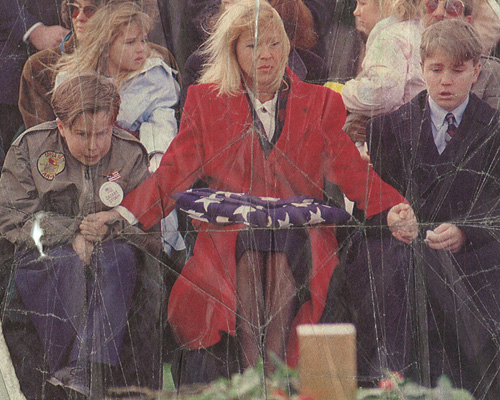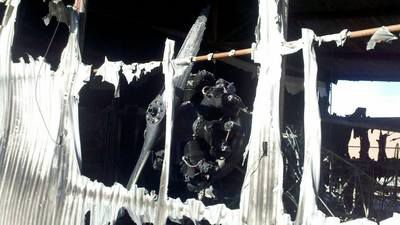Trashology in Duluth, behind school suspensions, after the fire in South St. Paul, the end of the apostrophe, and music for the locked-out soul.
There are are more glamorous ways to get out of town — the summer cabin, for example — but probably none as fascinating as Judy and Elmer Gilow, owners of a Winona company who are culling through the mysteries of Duluth this week. And by “mysteries,” I mean your trash, Duluth.
They’re trying to figure out what and why we choose to toss in the trash, the Duluth News Tribune reports.
“We’ve seen it all. Human remains. Dead animals. Nothing would surprise me now,” Elmer Gilow said as he dumped a container of rotten potato salad into the food category bin. And, by the way, the human remains weren’t found in Duluth.
On Wednesday the Gilows were sorting with their daughter, Kari Babler, and business partner Mike Rogers. The Minnesota natives sort garbage throughout the U.S. for agencies that keep track of solid waste.
“The dead animals are the worst — they smell REALLY bad,” Judy said.
“The worst is when it gets really hot or cold,” Elmer said.
“We had 105 degrees in Nebraska last year, and that was awful,” Judy added. “We do this part time, maybe eight or 16 weeks each year. … We’ve been as far away as Hawaii. … But I wouldn’t want to do this job full time.”
A lot of what they find is a failure — things that could have been composted or recycled. They’re expecting to find much more plastic this year than in recent years because of the explosion of single-serving packaging now.
It’s not surprising the couple is finding lots of rotten food. A study a few years ago found Americans throw away 40 percent of their food.
Saint Paul school officials say the number of suspensions of students is down after criticism over the number of minority students suspended for bad behavior. But that may not mean that behavior is improving, the Star Tribune reports.
The district class removed “continual willful disobedience” from the list of violations for which students could be suspended, and it also gave bonus pay to principals at pay where suspensions were reduced. Voila! Suspensions were reduced.
At St. Paul Federation of Teachers headquarters, union President Mary Cathryn Ricker said that she’s heard varied opinions from teachers as to whether the push to lower suspension rates has improved classroom behaviors. Some see it as a genuine effort to improve the school environment, she said, while others say it’s hiding work that needs to be done about disruptive acts.
Some students have weighed in on how safe they feel at school. Nick Faber, a veteran science teacher, surveyed third- through sixth-graders at his school about bullying and school safety. Nearly one-fourth said they felt “kind of not safe” or “not safe at all” at school, he said. Nearly two-thirds reported having been pushed or shoved at least once in the previous week. Teachers need professional development to help kids who’ve had trauma and chronic stress, and district administrators ought to put more resources there, rather than simply saying, “stop suspending,” Faber said.
This is what a classic Stearman airman looks like in typical condition.
This what a classic Stearman looks like when it burns…
I finally got a chance last evening to take a look at the damage from the fire that swept through the hangar, and several others earlier this week at Fleming Field in South St. Paul. The blaze started apparently while the plane’s owner refueled the airplane without ventilation.
Here’s another view of the fuselage.
Related aviation: Here’s a story you don’t hear every day – someone taking responsibility. A helicopter lost power over Honolulu and the pilot had seconds to act. Everybody lived. Then, risking legal consequences, the mechanic who worked on the helicopter stepped forward to accept responsibility. Now the insurance companies are suing him and he says he won’t fight it.
Hawaii News Now – KGMB and KHNL
The end of the apostrophe may be at hand, Slate suggests today.
The number of bloggers and websites suggesting that we get rid of the apostrophe for good has increased dramatically in recent years–and their position is not taken up as some sort of joke. Those who maintain the Kill the Apostrophe website, for instance, take this stuff seriously. The site’s manifesto notes that the apostrophe “serves only to annoy those who know how it is supposed to be used and to confuse those who dont.” It asserts that apostrophes are redundant, wasteful, snobbish, and anachronistic in an era of text messaging. Apostrophes “consume considerable time and resources” and, according to the website, “Tremendous amounts of money are spent every year by businesses on proof readers, part of whose job it is to put apostrophes in the ‘correct’ place–to no semantic effect whatsoever.” We’d all be “better off without em.”
More from the learned world: Anything is possible, people. A fairly undistinguished professor at the University of New Hampshire proved a math theory that, apparently, the math world thought would not be proven in their lifetimes.
Says Boston.com…
For more than a century–and perhaps as far back as ancient Greece–mathematicians have conjectured there are an infinite number of prime numbers separated by two. That would mean that there are an infinite number of pairs such as 3 and 5, or 41 and 43, or 269 and 271. What Zhang showed was actually that there were an infinite number of primes separated by 70 million. As any child who knows how to count knows, 70 million is a far from two, but Zhang’s proof–of something called the “bounded gaps conjecture”–excites mathematicians because it is the first time anyone has proven there are an infinite number of primes separated by an actual number.
5) MUSIC FOR THE LOCKED-OUT SOUL
What do Minnesota Orchestra musicians do when they’re locked out? The play. And teach.
MN Orchestra Visits MHS from Minnetonka Public Schools on Vimeo.
Bonus I: Kid President is back. This is a good thing.
Bonus II: More on why Daniel Alvarez is padding back to Minnesota.
Bonus III: It’s become a Memorial Day tradition on NewsCut. The story behind the picture.

(© John Francis Ficara)
If you’ve got a story to share about one who served, please post it below.
TODAY’S QUESTION
The number of cabin owners in Minnesota has dipped down a bit from 125,000 in 2005, to 122,000 in 2012, according to Jeff Forester, Executive Director, Minnesota Lakes and Rivers Advocates. But time at the lake is still an important tradition for many Minnesotans.
Today’s Question: Is owning a cabin part of your Minnesota dream?
WHAT WE’RE DOING
Daily Circuit (9-12 p.m.) – First hour: Friday roundtable of political reporters discusses the legislative session.
Second hour: What if we never run out of oil?
Third hour: Tom Weber hosted Science Night Minnesota in front of a capacity crowd at the Fitzgerald Theater in St. Paul this week. The topic was Mars exploration and the event featured a conversation with the chief scientist of the Mars Curiosity rover, John Grotzinger.
MPR News Presents (12-1 pm): Historian David Blight, speaking at the Minnesota History Center about “Race and Reunion: The Civil War in American Memory.”
Science Friday (1-2 p.m.) – Tech tips for older adults. Plus, why houses with dogs might be more diverse germ-wise.
All Things Considered (3-6:30 p.m.) – When author Richard Rubin tracked down the last veterans of World War I, he unearthed long lost stories. Stories the men had not talked about in 50, 60, even 70 years. Why so long? The veterans said: it had been decades since anybody asked them about the war. NPR reports on the last of the doughboys.



